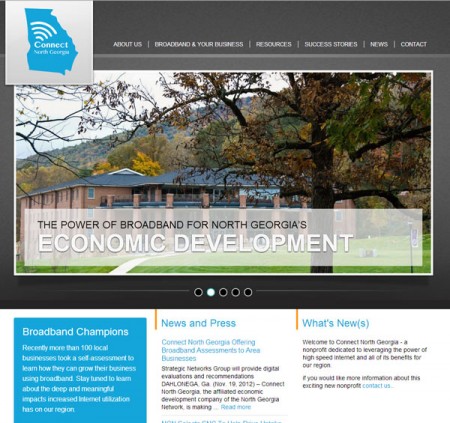In working across the globe and working with multiple carriers deploying new, more robust broadband networks, Strategic Networks Group consistently comes up against the notion that once the network is built, adoption will naturally follow. “Build it and they will come” is a school of thought that expresses the great hope that potential subscribers will naturally adopt, however this notion goes against what we have always known about technology adoption.
Meanwhile, broadband is broadband for many consumers and businesses – who do not see the difference, nor what is possible with ultra-fast broadband (e.g. fiber / Fiber-to-the-Home). On the other hand, organizations like US Ignite are forming to promote “Next generation Applications,” specifically new applications in education, healthcare, clean energy, public safety, and workforce development, including advanced manufacturing. These require the ultra-fast broadband connectivity which the networks being rolled out today will provide. And before we get to “Next generation applications,” consider the bandwidth required to support online collaboration so critical to being competitive in a 21st century economy.
http://www.muniwireless.com/2012/08/30/how-to-get-people-to-sign-up-for-ftth/
Posted onDr. Maryalice Wu and Ms. Shavion Scott attended the 2012 Illinois Broadband Research Conference at the University of Illinois at Chicago to present on behalf of the Center for Digital Inclusion and its work on the Urbana-Champaign Big Broadband project (UC2B). The conference was hosted by Partnership for a Connected Illinois (PCI), also known as Broadband Illinois, a statewide, nonprofit organization. As UC2B launches as the fastest, one of its kind broadband project in the nation designed to create digitally inclusive communities in Urbana and Champaign, Broadband Illinois seeks to foster and support broadband innovation statewide. Their mission is to ensure broadband access throughout the State of Illinois, maximize broadband’s impact and use, and collect and publish broadband-related data, information, and research. You can learn more about them at www.broadbandillinois.org.
Why good troubleshooting technology is important for successful broadband investments
Posted by Marcus Jonsson on  I participated at the Norwegian fiber conference “Fiber 2020”, arranged by the Norwegian “Fibersellskapet” in January 2013. There was a long list of interesting speakers lined up, for example Karin Ahl, president at the FTTH council, and Frode Støldal, the CTO of Telenor. There was however one speech in particular that caught my interest more than the others, the speech from Michael Curry, President at the Strategic Networks Group.
I participated at the Norwegian fiber conference “Fiber 2020”, arranged by the Norwegian “Fibersellskapet” in January 2013. There was a long list of interesting speakers lined up, for example Karin Ahl, president at the FTTH council, and Frode Støldal, the CTO of Telenor. There was however one speech in particular that caught my interest more than the others, the speech from Michael Curry, President at the Strategic Networks Group.
Taking the Best of Broadband Strategies to Maximize Growth
by Michael Curri
 For broadband networks receiving public investment, economic development is an inherent driver and critical to the success of the network. But how do you choose an economic development strategy which leverages the new network? You can take a business attraction ‘because we built it they will come’ approach, or you can ‘grow your own’ local businesses. It’s a fork in the road that you can choose a direction, or just take it and develop an approach with elements of each.
For broadband networks receiving public investment, economic development is an inherent driver and critical to the success of the network. But how do you choose an economic development strategy which leverages the new network? You can take a business attraction ‘because we built it they will come’ approach, or you can ‘grow your own’ local businesses. It’s a fork in the road that you can choose a direction, or just take it and develop an approach with elements of each.
SNG helps businesses understand broadband benefits, drive uptake.
by Doug Adams
 Over the past month, SNG has been helping ARRA pioneer North Georgia Network (NGN) kickoff the next step in their broadband journey – driving utilization.
Over the past month, SNG has been helping ARRA pioneer North Georgia Network (NGN) kickoff the next step in their broadband journey – driving utilization.
They see this as, of course, an opportunity to be a sustainable project. But more importantly to Bruce Abraham and his new not-for-profit Connect North Georgia, it is an opportunity to help North Georgia grow through the meaningful use of broadband and its advanced applications.
Everyone thinks they have data… but what is it that makes a difference?
by Michael Curri
Every ten years, the US Government conducts a census to provide general demographics of regions and population overviews. But this is aggregated and basic information that is challenging to use as a sole source for decisions. And so additional research and data is required as strategies and policies are developed.
 Unfortunately, in today’s broadband research world – most ‘data providers’ are simply giving you census data – basic information that is insufficient when trying to make broadband strategy decisions. Census data is only an inventory of the current situation and disregards demand.
Unfortunately, in today’s broadband research world – most ‘data providers’ are simply giving you census data – basic information that is insufficient when trying to make broadband strategy decisions. Census data is only an inventory of the current situation and disregards demand.
North Georgia Network Asks SNG to Help Demonstrate Value of Upgrading to Ultra-Fast Broadband
As ARRA pioneer North Georgia Network (NGN) is nearing completion, they’ve found themselves faced with the age-old technology challenge – getting people to understand the value and adopt the new technology. It’s a common mistake for network operators to assume that their market will see broadband as a utility… a no brainer that will see automatic uptake… the “build it and they will come” camp. What this group misses is that better/faster Internet service is an UPGRADE for most – an audience of households, businesses, and organizations that may be “under” served, but not UNserved.
 All this to say – NGN recognizes the need to make a compelling case to move from current broadband service to the ultra-fast fiber service NGN is now offering. With this recognition, NGN looked for a partner to help drive adoption and uptake, selecting SNG, our proprietary solutions and unparalled research database to help deliver a compelling business case for businesses and organizations to move to a more robust broadband service.
All this to say – NGN recognizes the need to make a compelling case to move from current broadband service to the ultra-fast fiber service NGN is now offering. With this recognition, NGN looked for a partner to help drive adoption and uptake, selecting SNG, our proprietary solutions and unparalled research database to help deliver a compelling business case for businesses and organizations to move to a more robust broadband service.
by John de Ridder
 Last year, we discussed how North Carolina and Tennessee were putting a stop to public broadband investment competing with private investment[i]. Meanwhile at the other extreme, the Australian Government is making a massive public investment in a national fiber access network (the NBN). SNG’s new white paper, EU Guidelines for Public Investment in Broadband, reviews the rules proposed in Europe (EU)[ii] for a more sensible division of roles between private and public investment in broadband.
Last year, we discussed how North Carolina and Tennessee were putting a stop to public broadband investment competing with private investment[i]. Meanwhile at the other extreme, the Australian Government is making a massive public investment in a national fiber access network (the NBN). SNG’s new white paper, EU Guidelines for Public Investment in Broadband, reviews the rules proposed in Europe (EU)[ii] for a more sensible division of roles between private and public investment in broadband.
The promise of faster broadband is unlikely to drive consumers to take up new fibre-based services, according to a briefing paper from broadband economists Strategic Networks Group.
SNG has been collecting information about broadband utilisation in a number of regions around the world; it said that once the build phase of ult

ra-fast broadband network initiatives wind down, network operators are finding that businesses, organisations, and individuals are not adopting the services in the numbers they had planned.

The promise of faster broadband is unlikely to drive consumers to take up new fibre-based services, according to a briefing paper from broadband economists Strategic Networks Group.
SNG has been collecting information about broadband utilisation in a number of regions around the world; it said that once the build phase of ultra-fast broadband network initiatives wind down, network operators are finding that businesses, organisations, and individuals are not adopting the services in the numbers they had planned.
They said that one of the main problems is that “faster” is not a benefit, while promising “a new world of possibilities” was too vague to attract demand. “Benefits are what the pragmatist looks for when making a change or adopting a technology. So is it any wonder that “faster,” a feature, is not driving the network uptake desired?” argued the paper’s authors, Doug Adams and Michael Curri.
“Ultra-fast broadband networks are no different than the lifecycle of every technology service product since “high tech” was a wheel. It takes time – time that most networks just cannot afford.”
According to SNG data, users are typically slow to adopt applications such as teleworking, rich media and e-business services. However, it is these types of services that it said were key to the economics of fibre broadband.
“Getting past your network’s reliance on innovators and early adopters and across the chasm requires demonstrating value to the more pragmatic of technology adopters, the early and late majority,” it said.
“Unfortunately, the slow to adopt e-solutions are better served with ultra-fast broadband… so carriers are dealing with two challenges: 1) making the e-solutions relevant; and, 2) driving uptake so that individuals and organisations can realise these benefits.”
Geoff Long
